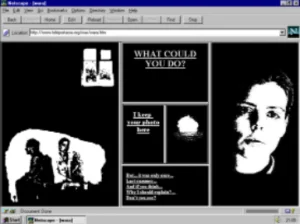Crypto Art in the Context of Art History: A Cultural and Technological Shift
The question of whether NFTs are art and how they fit into art history has been widely debated in recent years. A look at the past reveals a clear pattern: art has always been closely linked to cultural and technological developments. From the rediscovery of perspective during the Renaissance to the invention of photography, the rise of early digital art, and the emergence of net art, artistic expression has continually evolved.
Today, with blockchain technology, we are witnessing another transformation – one that is not only revolutionizing digital art but also creating entirely new opportunities for artists, museums, and collectors.
Cultural and Technological Shifts as Drivers of Artistic Innovation
Major artistic transformations often coincide with profound societal and technological changes. Each new medium challenges traditional artistic methods and prompts a redefinition of what art can be.
From the Renaissance to Photography: Shifting Perspectives
In the 15th century, perspective became a fundamental element of artistic practice, marking a significant shift in how the world was depicted. While people in the Middle Ages already understood the principles of perspective, they chose not to apply them in art. Their worldview was centered on the afterlife, prioritizing spiritual symbolism over naturalistic representation. With the Renaissance, however, came a cultural transformation – one that emphasized science, nature, and human experience. This shift in mindset encouraged artists like Leonardo da Vinci to explore new ways of portraying reality, using mathematics and optics to create a more lifelike and structured depiction of space.
Centuries later, the invention of photography in the 19th century disrupted this pursuit of realism. If a machine could capture reality with perfect accuracy, what purpose did painting serve? This led to a crisis in representation that directly fueled the rise of modernist movements. Impressionism, cubism, and abstraction emerged as responses, shifting art from an external reality to the subjective experience of perception.
The Birth of Digital Art and Net Art
A similar shift occurred with the advent of computers in the 20th century. In the 1960s, pioneers like Frieder Nake and Vera Molnár began using algorithms to create art, exploring how machines could be programmed to generate aesthetic forms. Their work laid the foundation for generative art – a field that remains deeply relevant in the age of NFTs.
In the 1990s, with the rise of the internet, artists like Olia Lialina embraced digital connectivity as an artistic medium. Her work in net art questioned authorship, interactivity, and the nature of digital space. These developments anticipated many of the debates surrounding NFTs today: What does ownership mean in a digital world? How do digital artworks exist across multiple platforms?
NFTs, Walter Benjamin, and the Return of Originality
As digital art became more prevalent, a fundamental issue emerged: the loss of uniqueness. Unlike a painting or a sculpture, a digital file can be copied infinitely without any loss of quality. This problem was famously discussed by Walter Benjamin in his 1936 essay “The Work of Art in the Age of Mechanical Reproduction”. He argued that mechanical reproduction strips an artwork of its aura – its unique existence in time and space.
NFTs present an intriguing solution. By linking a digital artwork to a blockchain-based certificate, they create a new kind of “originality.” While the artwork itself remains infinitely replicable, the NFT serves as a unique marker of ownership. This is not a return to traditional uniqueness but rather a new form of digital scarcity. An example is Tyler Hobbs famous generative artwork Fidenza.
NFTs and Baudrillard’s Hyperreality
Jean Baudrillard’s concept of hyperreality takes this discussion further. In his 1981 work “Simulacra and Simulation”, he described a world where representations no longer point to an original reality but instead become self-contained signs. NFTs fit precisely into this framework: their value often derives less from the artwork itself and more from their existence as a tradable token. They create a paradox – an “original” that exists only as a digital certificate, separate from the infinitely reproducible artwork it represents.
This shift is not unique to NFTs but reflects a broader transformation in how we define authenticity and value in an increasingly digital world. The question is no longer whether NFTs can recreate the aura of traditional artworks but whether they signal a new way of understanding art itself – one that is deeply embedded in the structures of the digital age. Crypto artist XCopy, for example, explores themes of originality and duplication in his work.
The Future of NFTs and Digital Art: Every Era Has Its Own Art
Looking at art history, one thing becomes clear: every era has its own art – shaped by the cultural and technological realities of its time. Just as the Renaissance revolutionized perspective, photography redefined painting, and early digital artists paved the way for computer-generated art, blockchain technology is ushering in a new paradigm.

Art has always evolved alongside new tools and ideas. What initially seems disruptive often becomes the foundation for future artistic expression. NFTs are not replacing traditional art but expanding its possibilities, allowing artists to explore new creative frontiers and engage with audiences in unprecedented ways.
Museums, as the custodians of art history, face the challenge of adapting to this shift. Their role is no longer just to preserve physical masterpieces but to contextualize and integrate digital art into the broader narrative of artistic evolution. By embracing these changes, they can help shape the future of art rather than merely documenting its past.
What we are witnessing today is not just a technological revolution but a cultural transformation. The way we create, distribute, and experience art is changing – and as history has shown, each transformation brings new possibilities. NFTs are a part of this ongoing story, securing digital art’s rightful place in the artistic canon of the future.
Elisabeth Mühlbacher is an Art Manager at Validvent, specializing in guiding collectors in building meaningful CryptoArt collections. With a deep passion for the CryptoArt space as a pioneering force within the traditional art world, she is dedicated to contextualizing digital art and its cultural significance.
Elisabeth curates innovative pop-up exhibitions that bridge the gap between digital and physical art experiences, fostering a deeper understanding of CryptoArt. She closely observes the evolving CryptoArt market, providing insights into its trends and developments. Additionally, she organizes informative workshops to educate collectors, artists, and institutions about the dynamics of the CryptoArt space.
Holding a master’s degree in art history and Image Science, Elisabeth has extensive experience in the art sector, having worked in both galleries and auction houses. She is also the initiator of Frame It, a physical pop-up gallery exhibiting upcoming Austrian CryptoArtists. She drives innovation at the intersection of art and technology.
Through her work, Elisabeth continues to push the boundaries of how we experience, collect, and engage with art in the digital age.




